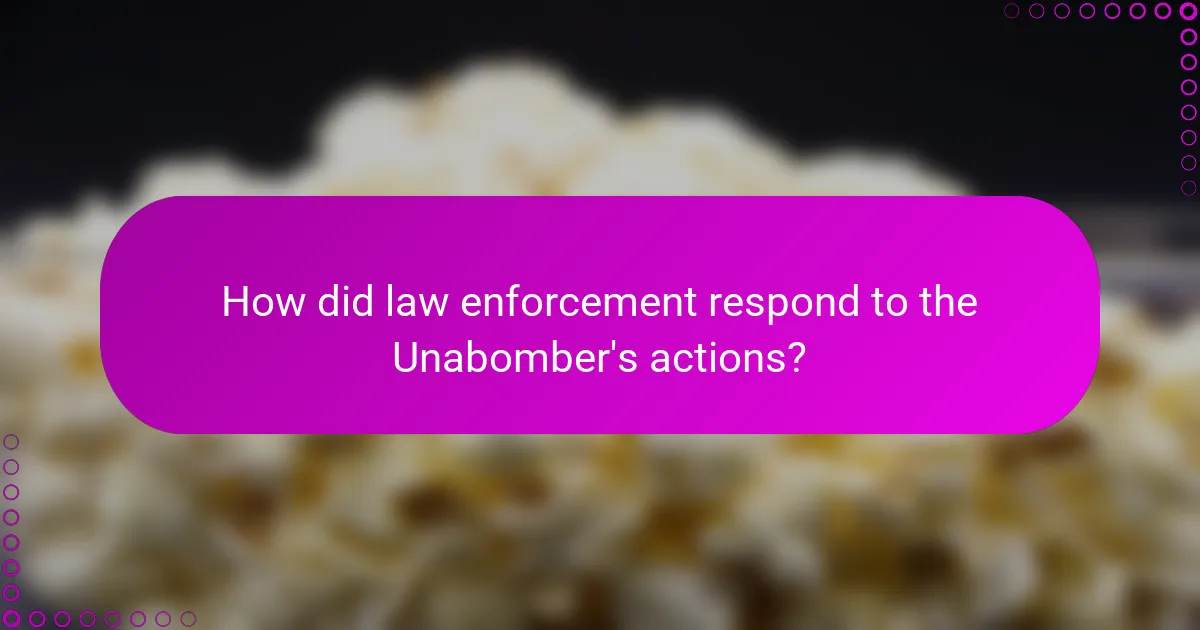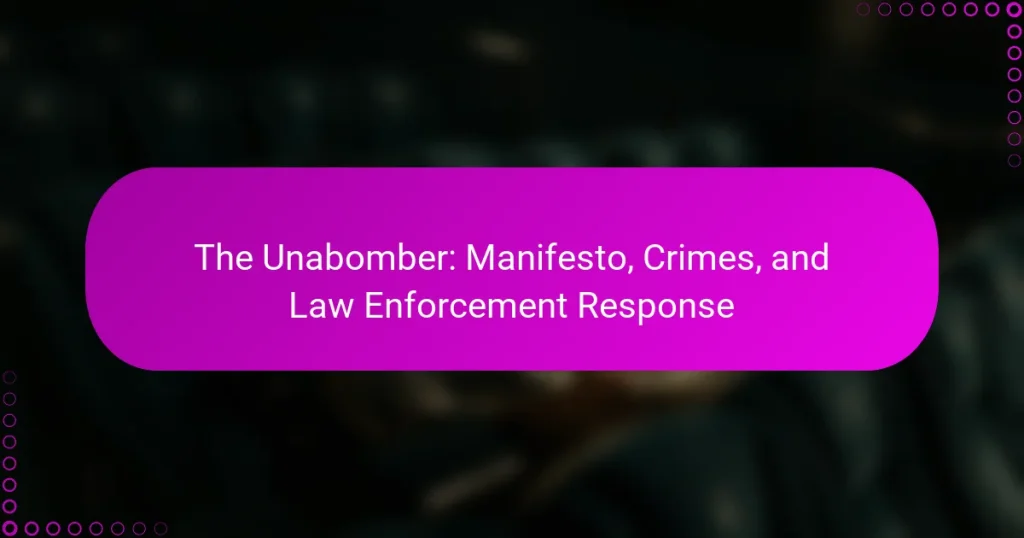The Unabomber, the nickname for Ted Kaczynski, is known for a nationwide bombing campaign conducted from 1978 to 1995, targeting individuals associated with modern technology and industrial society. His actions resulted in three fatalities and 23 injuries, while his manifesto, “Industrial Society and Its Future,” critiques the impact of technology on society. The extensive investigation by law enforcement, including the establishment of the Unabomber Task Force by the FBI, culminated in Kaczynski’s arrest in 1996, following a breakthrough from his brother recognizing the manifesto’s writing style. The case raises significant issues related to mental health, radicalization, and the ethics of technology, emphasizing the need for constructive dialogue and improved collaboration among law enforcement agencies to address domestic terrorism effectively.

What is the Unabomber and what is his significance?
The Unabomber is the nickname for Ted Kaczynski, an American domestic terrorist. He conducted a nationwide bombing campaign from 1978 to 1995. Kaczynski targeted individuals involved with modern technology and industrial society. His actions resulted in three deaths and 23 injuries. The significance of the Unabomber lies in his critique of technology and its impact on society. He articulated his views in a manifesto titled “Industrial Society and Its Future.” This document was published by major newspapers at Kaczynski’s request. His case raised questions about mental health, violence, and the ethics of technology. It also highlighted the challenges law enforcement faces in tracking domestic terrorists.
Who was the Unabomber?
The Unabomber was Ted Kaczynski, an American domestic terrorist. He carried out a nationwide bombing campaign from 1978 to 1995. Kaczynski targeted individuals involved in modern technology and industrial society. His attacks resulted in three deaths and 23 injuries. He was known for sending homemade bombs through the mail. Kaczynski’s manifesto, “Industrial Society and Its Future,” criticized technological advancement. He was captured in 1996 after his brother recognized his writing style. Kaczynski is serving a life sentence without parole.
What were the early life and background of the Unabomber?
The Unabomber, whose real name is Theodore John Kaczynski, was born on May 22, 1942, in Chicago, Illinois. He grew up in a middle-class family with a strong emphasis on education. Kaczynski exhibited exceptional intelligence from a young age. He skipped the second grade and was often isolated from peers.
He attended Harvard University at the age of 16. Kaczynski earned a Bachelor’s degree in mathematics and later completed a Ph.D. at the University of Michigan. His academic success was overshadowed by social difficulties and a growing disdain for modern society.
Kaczynski retreated to a remote cabin in Montana in 1971. He lived a primitive lifestyle, rejecting technological advancements. His early life experiences and academic background significantly influenced his later actions as the Unabomber.
What led to the Unabomber’s criminal activities?
The Unabomber’s criminal activities were primarily driven by his radical anti-technology beliefs. He believed that modern society and technological advancements were detrimental to human freedom and the environment. His manifesto, titled “Industrial Society and Its Future,” outlined his views on the dangers of industrialization. Personal experiences, including isolation and a troubled upbringing, contributed to his extreme ideology. Ted Kaczynski, the Unabomber, felt alienated and disillusioned by societal norms. This led him to resort to violence as a means of expressing his dissent. His actions were aimed at drawing attention to his anti-technology message. Ultimately, his criminal activities stemmed from a combination of ideological convictions and personal grievances.
What is the Unabomber’s manifesto?
The Unabomber’s manifesto is titled “Industrial Society and Its Future.” It critiques modern society and technology. The document argues that technological advancement erodes human freedom and autonomy. It advocates for a return to simpler, pre-industrial ways of living. The manifesto was published in 1995 in major newspapers. It was part of a deal to stop his bombing campaign. The author, Ted Kaczynski, believed that society’s progress leads to widespread psychological suffering. The manifesto has been analyzed for its philosophical and sociopolitical implications.
What are the main themes and arguments presented in the manifesto?
The main themes in the Unabomber’s manifesto include anti-technology sentiment, criticism of modern society, and advocacy for a return to primitive living. He argues that technological advancement threatens human freedom and the environment. The manifesto critiques industrial society for creating psychological suffering and social disconnection. It emphasizes the need for radical change to avoid ecological disaster. The author calls for a revolution against technological systems that control individuals. He believes that personal autonomy is compromised by the complexities of modern life. The manifesto serves as a warning about the dangers of unchecked technological progress.
How did the manifesto impact public perception of the Unabomber?
The manifesto significantly influenced public perception of the Unabomber. It presented his ideology in a structured manner, which some viewed as thought-provoking. Many individuals were intrigued by his critiques of modern technology and industrial society. This led to a polarized response, with some sympathizing with his anti-technology stance. The manifesto’s publication also humanized the Unabomber, shifting the narrative from a mere criminal to a complex figure with philosophical beliefs. Consequently, it garnered media attention, amplifying discussions about technology’s role in society. The FBI received numerous tips after its release, indicating its impact on public awareness. Overall, the manifesto transformed the Unabomber from an anonymous criminal into a controversial public figure.
What crimes did the Unabomber commit?
The Unabomber, whose real name is Ted Kaczynski, committed a series of bombings. He was responsible for three deaths and 23 injuries from 1978 to 1995. Kaczynski targeted individuals associated with modern technology and industrial society. His crimes included mailing homemade bombs to victims. He also detonated bombs in public places. His actions were part of a broader anti-technology ideology. Kaczynski was apprehended in 1996 and later sentenced to life in prison. His manifesto, “Industrial Society and Its Future,” outlined his beliefs and motives.
What were the key incidents and their outcomes?
The key incidents related to the Unabomber include a series of bombings that occurred between 1978 and 1995. These incidents resulted in three deaths and 23 injuries. The first bombing took place in 1978 at Northwestern University, injuring a university professor. In 1985, a bomb killed a computer store owner in California. In 1993, a bomb targeted the University of California, injuring a graduate student. The final bombings occurred in 1995, leading to the deaths of a timber industry lobbyist and a marketing executive. The outcomes included a lengthy FBI investigation and the eventual capture of Theodore Kaczynski in 1996. Kaczynski was sentenced to life in prison without parole after pleading guilty in 1998.
How did the Unabomber’s actions evolve over time?
The Unabomber’s actions evolved from targeted bombings to a broader campaign against modern society. Initially, Theodore Kaczynski focused on universities and airlines, sending homemade bombs between 1978 and 1995. His first bomb injured a university professor in 1978. Over time, his attacks became more sophisticated and deadly. He killed three people and injured 23 others over nearly two decades. In 1995, he escalated his actions by publishing his manifesto, “Industrial Society and Its Future,” which called for a revolution against technology. This manifesto led to increased media attention and ultimately to his identification by his brother in 1996. Kaczynski’s evolution reflected a shift from personal grievances to a broader ideological battle against technological advancement.

How did law enforcement respond to the Unabomber’s actions?
Law enforcement responded to the Unabomber’s actions with an extensive investigation. The FBI established the Unabomber Task Force in 1979. This task force focused on tracking down the individual responsible for a series of bombings. They analyzed evidence from the crime scenes and developed profiles of the suspect. In 1996, law enforcement released a manifesto written by the Unabomber. This led to a significant breakthrough when his brother recognized the writing style. The brother provided this information to authorities, which ultimately resulted in the Unabomber’s arrest in April 1996. The investigative efforts spanned nearly two decades and involved multiple agencies.
What strategies did law enforcement employ to capture the Unabomber?
Law enforcement employed several strategies to capture the Unabomber. They utilized a combination of forensic analysis and behavioral profiling. Investigators analyzed the Unabomber’s bomb designs for unique characteristics. They also studied his writings for linguistic patterns. The publication of his manifesto in 1995 was a pivotal strategy. This led to tips from the public, including identification by his brother. The FBI established a task force dedicated to the case, enhancing collaboration. They employed surveillance techniques and monitored potential suspects. These combined efforts ultimately resulted in the arrest of Theodore Kaczynski in 1996.
What challenges did law enforcement face during the investigation?
Law enforcement faced several challenges during the Unabomber investigation. One major challenge was the lack of physical evidence, as the Unabomber operated remotely and used homemade bombs. This made it difficult to trace the origin of the materials used in the bombs. Additionally, the Unabomber’s ability to remain anonymous through mail and isolated locations complicated the investigation.
Another challenge was the lengthy timeline of the attacks, which spanned nearly two decades. This extended period allowed the Unabomber to refine his methods and avoid detection. Law enforcement also struggled with the complexity of the case, as it involved multiple jurisdictions and agencies. Coordination among these entities was often inefficient.
The Unabomber’s intelligence and meticulous planning presented further obstacles. He was adept at avoiding surveillance and took precautions to conceal his identity. Finally, the manifesto published in 1995 posed a unique challenge. While it provided insights into his motivations, it also led to a flood of false leads from individuals claiming to know the Unabomber. These factors collectively hindered law enforcement’s ability to capture him swiftly.
How did the FBI’s profiling techniques contribute to the case?
The FBI’s profiling techniques significantly contributed to the Unabomber case by narrowing down potential suspects. Profilers analyzed the Unabomber’s writings and behavior patterns. They identified traits indicating he was highly intelligent and had a strong anti-technology stance. This helped law enforcement focus on individuals with similar backgrounds. The profile suggested he was likely a male with a background in academia or engineering. This information guided investigators in their search. Ultimately, the profile led to the identification of Theodore Kaczynski as the primary suspect. Kaczynski’s arrest was influenced by the profile’s accuracy and detail.
What role did public involvement play in the investigation?
Public involvement was crucial in the investigation of the Unabomber. The FBI launched a campaign to solicit tips from the public. This effort included a widely publicized appeal for information about the Unabomber’s identity. The release of the manifesto in 1995 prompted many people to come forward. Some individuals recognized the writing style and ideas. This led to the identification of Theodore Kaczynski as a suspect. Ultimately, Kaczynski was apprehended due to a tip from his brother. Public engagement significantly advanced the investigation and contributed to its resolution.
How did the publication of the manifesto influence public engagement?
The publication of the manifesto significantly increased public engagement with its themes. It sparked widespread debate about technology and society. Many readers were drawn to its controversial viewpoints. This led to heightened media coverage and public discussions. The manifesto’s accessibility online facilitated its rapid dissemination. As a result, various organizations and individuals began to analyze its content critically. Some expressed concern over its violent rhetoric. Others found resonance in its critique of modern life, prompting further exploration of its ideas.
What were the outcomes of tips and leads from the public?
The outcomes of tips and leads from the public regarding the Unabomber case were significant. Public tips led to the identification of Theodore Kaczynski as a suspect. In 1996, Kaczynski’s brother recognized his writing style in the manifesto published by the Washington Post. This recognition prompted him to contact law enforcement. The FBI received over 23,000 tips during the investigation. Many of these tips helped narrow down the search for the suspect. Ultimately, Kaczynski was arrested in April 1996, largely due to the information provided by the public. This collaboration between law enforcement and citizens played a crucial role in solving the case.

What lessons can be learned from the Unabomber case?
The Unabomber case teaches several key lessons about societal issues and criminal behavior. It highlights the dangers of radicalization and the impact of isolation on mental health. The case also underscores the importance of addressing grievances through constructive dialogue rather than violent actions. Law enforcement’s response demonstrates the need for improved communication and collaboration among agencies to prevent similar incidents. Additionally, the case serves as a reminder of the potential consequences of technology and industrialization on individuals’ lives. Understanding these lessons can aid in preventing future acts of domestic terrorism.
How can understanding the Unabomber’s motivations help prevent future incidents?
Understanding the Unabomber’s motivations can help prevent future incidents by identifying the psychological and ideological factors that drive such violence. His motivations were rooted in anti-technology beliefs and a desire to provoke societal change. By analyzing these motivations, law enforcement can better recognize warning signs in individuals who may share similar ideologies. This understanding can inform prevention strategies and intervention programs aimed at at-risk individuals. Additionally, public awareness campaigns can be developed to address the underlying issues that lead to radicalization. Historical cases show that understanding motivations can lead to effective profiling and threat assessment. For example, the FBI’s Behavioral Analysis Unit utilizes psychological profiles to prevent violent crimes.
What best practices can law enforcement adopt from this case?
Law enforcement can adopt several best practices from the Unabomber case. First, they should enhance inter-agency communication. The Unabomber case involved multiple jurisdictions, highlighting the need for seamless information sharing. Second, law enforcement should utilize behavioral analysis techniques. Profiling the suspect’s behavior helped narrow down potential leads. Third, they should engage the public effectively. The decision to publish the manifesto resulted in key tips from the public. Fourth, they must prioritize technology in investigations. Advanced forensic methods played a crucial role in identifying the suspect. Lastly, ongoing training in threat assessment is essential. This case demonstrated the importance of understanding and evaluating threats accurately. These practices can improve future law enforcement responses to complex cases.
How can communities enhance vigilance and reporting mechanisms?
Communities can enhance vigilance and reporting mechanisms by implementing structured communication channels. Establishing neighborhood watch programs encourages residents to report suspicious activities. Regular community meetings can facilitate discussions on safety concerns and reporting procedures. Training sessions on recognizing and reporting threats can empower community members. Utilizing technology, such as mobile apps, can streamline reporting processes. Data shows that communities with active reporting systems see quicker law enforcement responses. For instance, a study by the National Institute of Justice found that community engagement reduces crime rates. These strategies collectively foster a proactive environment for vigilance and reporting.
What resources are available for further understanding the Unabomber?
Books and documentaries provide valuable resources for understanding the Unabomber. “Industrial Society and Its Future” is the Unabomber’s manifesto, detailing his ideology. The book “Hunting the Unabomber” by James R. Fitzgerald offers insights from an FBI profiler involved in the case. The documentary “Unabomber: In His Own Words” features interviews and archival footage, providing a comprehensive view of his life. Additionally, academic articles analyze the psychological and sociological aspects of his actions. Online resources include the FBI’s official website, which outlines the case history and investigation details.
Where can one find comprehensive analyses of the Unabomber’s manifesto?
Comprehensive analyses of the Unabomber’s manifesto can be found in academic journals, books, and reputable online platforms. Notable sources include “Technological Slavery,” a collection of essays analyzing the manifesto. The journal “Critical Inquiry” has published articles examining its themes. Websites like JSTOR and Google Scholar offer access to scholarly articles on the subject. Additionally, various documentaries and podcasts discuss the manifesto’s implications. These resources provide in-depth perspectives and critical evaluations of the Unabomber’s ideas.
What documentaries or books provide deeper insights into the Unabomber case?
“Manhunt: Unabomber” is a documentary series that provides insights into the Unabomber case. It explores the FBI’s investigation and the psychological profile of Ted Kaczynski. “The Unabomber: In His Own Words” is another documentary that features interviews and archival footage. It delves into Kaczynski’s thoughts and motivations.
Books like “Every Last Tie” by John K. Williams offer a comprehensive look at Kaczynski’s life and crimes. “The Unabomber: A Desire to Kill” by David Kaczynski examines the familial aspects of the case. These resources collectively provide a deeper understanding of the Unabomber’s actions and the law enforcement response.
The Unabomber, also known as Ted Kaczynski, is an American domestic terrorist responsible for a bombing campaign from 1978 to 1995 that resulted in three deaths and 23 injuries. His manifesto, “Industrial Society and Its Future,” critiques modern technology and advocates for a return to simpler living, raising significant discussions about the impact of technology on society. The article explores Kaczynski’s background, motivations, key incidents of his criminal activities, the law enforcement response, and the broader societal lessons learned from his actions. Additionally, it highlights the role of public involvement in the investigation and provides resources for further understanding the Unabomber’s ideology and case.


